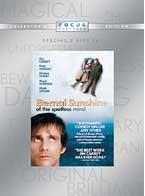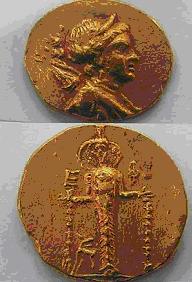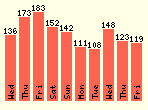| Sunday, September 3, 2006 |  |
|
|
|
3 Sep 2006 @ 10:43
Good Goddess!! Time has slipped away. I haven't disappeared, I have been spending as much time as possible near home. Spring and Summer I have spent time in the Creek moving rocks.
I feel inspired to begin sharing again. Plenty of news and things to happening in the world.
Glad to be back!
|
|
| Wednesday, January 25, 2006 |  |
|
|
|
 25 Jan 2006 @ 07:22 25 Jan 2006 @ 07:22
Tonight I watched Eternal Sunshine of the Spotless Mind with my housemates. I love the notion that we will be able to erase memories. How much more easily one could move on in life. But I wonder, would the lessons of Love be lost as well? And if the memories attached to that person also had to be erased, one might lose the whole chunks of time, right? Because if the Love is deep and shared between two people, when you are together, everything in your life is colored or shared with the other.
Even knowing that now, I find myself with such a heartache still, I might entertain the thought if the technology were available.
Hmm, who knows. I think I will sleep on that one. Only two more days until I fly to Jamaica! Maybe the equatorial sun will help me burn through the last stages of release.
OK enough about my sad story. I could recommend this film.
|
|
| Friday, January 13, 2006 |  |
|
|
|
 13 Jan 2006 @ 03:26 13 Jan 2006 @ 03:26
"Yankee Doodles: American Empire in the Philippines, 1896-1907" January 12 - February 8, 2006 Curated by Abe Ignacio, Enrique de la Cruz, Jorge Emmanuel, and Helen Toribio
Opening Reception on Thursday, January 12, 2006, 6:00 - 8:00 p.m.
Gallery Talk by Guest Curators Abe Ignacio and Enrique de la Cruz on Saturday, February 4, 2006, 1:00-3:00 p.m.
The Sam Francis Gallery Crossroads School 1714 21st Street Santa Monica, CA 90404 Gallery Hours: Monday-Friday, 1-3 p.m. (For more information call the Sam Francis Gallery at 310-829-9391 ext 425)
---------------- Vivid Images Bring Hidden History to Light
The Forbidden Book: The Philippine American War in Political Cartoons, by Abe Ignacio, Enrique de la Cruz, Jorge Emmanuel and Helen Toribio. T'Boli Publishing and Distribution, 2004 San Francisco.
First published in Socialism and Democracy Journal #37, this review also appeared in Our Own Voice Literary E-zine: Filipinos in the Diaspora and the Asian American Movement E-Zine
By Max Elbaum
The Spanish-American War of 1898 lasted six months and cost 2,446 lives. It is featured prominently in all U.S. history textbooks.
The Philippine-American War of 1899-1914 lasted 15 years and killed at least 100,000 people. It is hardly mentioned even in college-level history texts and has been all but erased from the U.S. public memory - even within the (non-Filipino-American) left.
Yet the Philippine-American War occupies a central place in the rise of the U.S. to become the 20th century's paramount imperial power. It was a pivotal episode in the intertwining of U.S.-style racism and empire-building, openly touted as the moment when the U.S. supplanted Britain in "taking on the white man's burden." And Washington's brutal assault on the Philippine independence movement was daily front page news at the turn of the century, with the New York World editorializing that "The American public eats its breakfast and reads in its newspapers of our doings in the Philippines."
The campaign to bury the history of U.S. manipulation, racism, pillage and annexation in the Philippines began even while the war was still underway. The Chicago Chronicle printed a cartoon in 1900 showing then-President William McKinley locking shut a book titled "True History of the War in the Philippines." The cartoon's title was "The Forbidden Book."
Now, 104 years later, The Forbidden Book has been opened. And the newly published work utilizing that title does even more than bring to light events that have been subject to a 100-year long cover-up. The volume is simultaneously a vivid illustration of the direct continuity between the ideologues of "manifest destiny" in 1900 and the neoconservative Project-for-a-New-American-Century crowd that is in charge of Washington's policies today.
The historical narrative provided by activist/historian authors Abe Ignacio, Enrique de la Cruz, Jorge Emmanuel and Helen Toribio is fact-filled, concise, and supplemented by a convenient timeline and extensive bibliography. But the heart and soul of this book lies in the reproduction of several hundred images - many in full color – from the U.S. popular media 1896-1907. The majority are political cartoons (a few are photographs) which appeared in U.S. newspapers and especially in the "illustrated magazines" (Puck, Judge and Life) which were the most influential opinion-makers of the period. Assembled mostly by co-author Ignacio via three decades of combing antiquarian bookstores, libraries and the internet, this unique collection gives The Forbidden Book the kind of gripping, eyewitness quality that would not be matched by text alone.
There is political subtlety in many of the cartoons, but most - especially the ones which favor the U.S. war - go right for the emotional jugular. They offer flag-waving, heroic images of "our troops" and demonic images of the "enemy." But what stands out above all is the blatant, let's-flaunt-it racism in the way Filipinos are portrayed, in particular the widespread transference of the era's racist images of African Americans to Filipinos.
Pictures worse than minstrel-show caricatures are commonplace, such as one in a cartoon depicting McKinley as a circus trainer and a Black/Filipino as one of many circus animals ("Trouble Ahead for the Trainer," 1906). Even a fond look back at outright slavery was not too much for pro-war cartoonists: Puck magazine proudly featured the image of Uncle Sam auctioning off a dark-skinned Filipino under the heading "Make Me an Offer" (1907).
Such images corresponded to events taking place within the U.S. as well as in the military's campaign of death and dehumanization abroad. In 1896, the same year Filipinos were beginning their independence struggle against Spain (to be continued against the U.S.), the U.S. Supreme Court approved the "separate but equal" doctrine in Plessy vs. Ferguson. An average of three Blacks a week were lynched across the South as white mobs cheered.
Is it any wonder that many of the African American soldiers sent to the Philippines in segregated units turned against the war? More than a dozen Black G.I.s defected to the side of the Filipino independence movement. Nine soldiers wrote an open letter that read "the time has come to break the silence so that you will see the folly of ...fighting these people who are defending their country against the cruel American invasion...." Cruel was an understatement: U.S. General Jacob Smith - a veteran of the Wounded Knee massacre of Native Americans - articulated official policy by ordering his troops to "take no prisoners" and "kill everyone capable of bearing arms... that means ten years of age."
The second most striking set of images are those portraying the large anti-imperialist opposition movement that developed within the U.S. The Anti-Imperialist League, founded in 1898, grew to a nationwide force with chapters in every major city; notables of the anti-imperialist cause included renowned writer Mark Twain, Hull House founder Jane Addams, journalist Joseph Pulitzer, first NAACP president Moorfield Storey, numerous senators and representatives and even Democratic Presidential candidate William Jennings Bryan. Derisively labeling these anti-imperialists "aunties" and portraying them as cowardly old women when not showing them stabbing U.S. soldiers in the back, pro-war cartoonists spared no sexist or racist taunt in ridiculing their targets. The "National Democratic Bed" - showing candidate Bryan embracing the caricature of an African/Filipino man - is only one among many cartoons that would make Karl Rove drool with envy.
Indeed, echoes of today's headlines resound from virtually every page. Reading about the "reconcentrado pens" used to hold Filipino prisoners conjures up the image of Abu Ghraib. Learning that the U.S. military orchestrated a provocation on the eve of a key congressional vote (and that McKinley manipulated news of it to win support for annexation by a single ballot) literally screams with parallels to Bush and Weapons of Mass Destruction. And substitute the image of an Iraqi or Palestinian for a Filipino in just about any cartoon and you get a close match to one or another image published in the U.S. press within the last three years.
Denial runs deep in U.S. society. But every day there are people opening their minds, questioning the national myth, and searching for the truth. The next time you run across someone embarked upon that journey, give them a copy of The Forbidden Book.
* * *
The Forbidden Book (176 pages, ISBN: 1-887764-61-5) is available for $24.95 softcover or $65.00 hardcover plus postage/handling ($7.50 softcover or $9.00 hardcover) from T'boli Publishing and Distribution, P.O. Box 347147, San Francisco, CA 94134; tiboli@comcast.net 415-337-5550.
Max Elbaum, active in antiwar and anti-racist movements since the 1960s, is the author of Revolution in the Air: Sixties Radicals Turn to Lenin, Mao and Che (Verso, 2002).
|
|
| Monday, January 9, 2006 |  |
|
|
|
 9 Jan 2006 @ 01:39 9 Jan 2006 @ 01:39
Wednesday, January 4, 2006
ROB MARSHALL
ANKARA - Turkish Daily News
One of two surviving golden coins stamped during the period of the foundation of the Kingdom of Pergamon is being exhibited at the Ere li Archaeology Museum in Konya.
Ere li Archaeology Museum Director Mehmet Bilici said the golden coins' importance is down to their potential for providing valuable evidence about the economic and social conditions of the Kingdom of Pergamon.
The other coin is still on display at the Bergama Museum in zmir.
Pergamon was an ancient city founded on the Aegean coast of Anatolia at the site of the present-day city of Bergama. Located 100 kilometers north of zmir in the Bak rçay River basin, Bergama is one of Turkey's oldest civilized settlements, inhabited from pre-historic times through the periods of the Ionic, Roman and Byzantine civilizations.
Noting that Pergamon was a city-state of the Roman Empire around 120 B.C., Bilici said that after establishing the realm the king stamped the coins as proof of the kingdom's independence from the Roman Empire. He added that they were also meant for commercial purposes to allow trade.
The stamped coins were then released for public use," Bilici said. "The independent Kingdom of Pergamon was founded in this way. There's a stylized statue relief of the goddess Artemis on the backside of the 24-carat gold coin, and the goddess' head is depicted on the front. … The coins are very valuable in terms of world archaeology and art history, he added.
How did the coin travel to central Anatolia?
Stressing that only two golden coins remain from that time, Bilici said the one exhibited in the Ere li Archaeology Museum was unearthed from a tomb on a hill located five kilometers east of Ere li during excavations in the region in 1974.
This golden coin, along with some other finds from the same tomb, is being exhibited at our museum. It'll be worthwhile to put these coins and the other unearthed items under comprehensive technical observation, as according to the age's religious beliefs coins were put into tombs for the dead as a gift to be given to the keeper of the Sirat Bridge, he said. However, it's a great secret as to how the coins came from Bergama to a central Anatolian settlement.
Bilici said Ere li will also be a place of major interest for archaeologists and art historians from all around the world if the body found in the tomb is proven to be one of Alexander the Great's commanders, as some archaeologists presume.
© 2005 Dogan Daily News Inc.
|
|
| Saturday, January 7, 2006 |  |
|
|
|
 7 Jan 2006 @ 03:57 7 Jan 2006 @ 03:57
Connie Rock
Licensed Midwife
2118 Wilshire Blvd #377
Santa Monica CA 90403
(310) 836-4200
December 26, 2005
This year has been a time of big transitions for the Hollywood Birth Center and me. On September 15, 2005 the Hollywood Birth Center officially closed its doors. I am currently facing disciplinary action with the California Medical Board that will affect not only my personal career as a midwife, but also midwifery in the State of California. I am writing to you to share with you the many factors leading up to this, to open the door for discussion with you and to urgently ask for your help.
When Tai and I started the Hollywood Birth Center back in 2000 we had a vision of creating a space where the families of Los Angeles could come to get complete prenatal care, birth their babies in a beautiful, nurturing space and be part of a community that supported them in their choices. Our commitment was to help individuals become empowered parents and to bring babies into the world in the most peaceful way possible. Despite many obstacles, in the 5 years we were open, we had the privilege of working with over 400 families.
Before opening HBC, I had completed 5 years of apprenticeship, had been a midwife for 3 years and had recently completed the California Challenge process, which was the only way for an experienced midwife to become licensed by the California Medical Board under recent midwifery legislation. Tai had been attending births as an apprentice for 5 years but still needed to complete the prescribed number of catches to go through the Challenge process and become licensed. Although Tai was my partner in the business, she was technically my apprentice and working under my supervision as her preceptor. Direct entry midwives have always received their training through apprenticeship although California law did not address it one way or another.
Tai, as many of you know, sat the challenge exam 3 times and was unable to pass part of the written section. 3 times was all that she was allowed and by not getting through the challenge process, she had no other way to become licensed except to go through an approved 3 year midwifery program. Her inability to pass the challenge exam created a huge dilemma for us because we had built the practice together and we were equal partners. We decided that she would mainly run the business and only attend births as a support person.
At some point the medical board became aware that she was an unlicensed partner and they began an investigation. The investigation was eventually dropped because no harm ever came to any clients and they could find no proof of Tai having practiced without me. The medical board, out of frustration, decided that because there wasn’t anything in the legislation about apprenticeship that they would interpret it as illegal. There was a notice sent out to all licensed midwives in California in fall of 2004 saying that we could not have apprentices. During this time I did not allow any of my apprentices do anything that could be considered ‘medical’. Many of you wrote letters to the medical board expressing outrage at this and the result was that apprenticeship was written into our legislation in January 2005.
In May, 2005 the medical board reopened their investigation and are charging me with “aiding and abetting in the illegal practice of midwifery” during the period 2001 through 2004. In other words, they want to discipline me for training and supervising midwives before the law specifically sanctioned such a practice. (It seems so unfair to have this happen when all of us who went through the challenge process were trained through apprenticeship long before the medical board was involved with us and they knew that). Since becoming licensed, I have trained many apprentices -4 who have passed their licensing exams and 1 who has finished her training and is sitting her exam in February. I have always been committed to training as many midwives as I could, believing that because the law did not specifically forbid it, and because I trained that way, it was legal.
During this stressful time I became ill with Fibromyalgia (an exhausting and painful immune disorder). I was unable to carry the load alone, so we hired other midwives to work with us, creating lots of financial strain. Finally, Tai and I decided that the best course of action was to sell the practice to other midwives who would carry on our vision for us. Unfortunately, Christine Anderson, the chiropractor who owns the building the birth center was in, was unwilling to lease the property to anyone we wanted to sell the practice to. Because neither Tai nor I had the energy to move the birth center in order to sell it, we chose to close the practice. We had clients who had paid in full due through October and our plan was to close at the end or October. Unfortunately we went bankrupt in July and had to close our doors on September 15th. Because Tai was unable to practice, she chose to leave at that time and move to Canada.
I continued to provide the care we had promised to our clients, with all of them choosing to birth in their homes. With the support of my apprentices, my family and many of our clients, we were able to create an amazing few months and had truly amazing births.
In August 2005, the medical board offered me a settlement where I would have to pay all the costs of the investigations plus 5 years of probation, 1 year of community service, an ethics class and only being able to practice under the direct supervision of an obstetrician. In effect this is a set up to not being able to practice anymore. I was ready to settle and move out of state, when I learned that the medical board intends to use my case to set a precedent to enforce ‘obstetric supervision’ with every licensed midwife in California.
California midwifery legislation says that all midwives must practice under the supervision of an obstetrician, but none of us can do that because the obstetricians who are willing to support us are threatened with losing their malpractice insurance if they supervise us. It also makes them liable for what we do, which isn’t fair to them. In reality we are all unable to comply with the law. The medical board is aware of this, but so far has not attempted to enforce the supervision issue.
What we have are collaborative relationships with obstetricians. This means that if we have a concern about one of our clients we can consult with, or refer our clients to see the obstetrician. Then, together we decide the best plan for care. If one of our clients develops a complication in labor, the obstetrician is on call for us and we can transfer into their care in the hospital. This works well for all of us. There is work being done by our state midwifery organization to change the ‘supervision’ wording in our legislation to ‘collaborative’, but it hasn’t happened yet.
The purpose of the medical board is to protect the public and ensure quality medical care, yet it seems that they are protecting the interests of the American College of Obstetrics and Gynecology (ACOG), who let us know at every medical board meeting that they do not want us to be able to practice. Regardless of the fact that we have better outcomes or maybe because that threatens them, they continue to try to get rid of us. I am not the only midwife in our area that is facing this type of disciplinary action, and some have had their license’s revoked.
So, in essence, what I thought was to be a personal loss may turn out to be a loss for every California licensed midwife. (Although I believe the biggest loss of all is to the future generations of mothers, fathers and babies who might not have the choice to receive the one-on-one attention that midwifery care provides).
In the end, this is not a personal or a professional issue. It is a women’s rights issue, and it affects all of us. This is not something I can fight alone. But I know that with the support of those of you who believe in the midwifery model of care, we can be a powerful voice for change. Only together can we create:
A world where all children are nurtured in tenderness and respect. All people thrive in their relationship with each other and the world. All of life flourishes.
My hearing with the medical board is scheduled for the week of January 23rd, 2006, only a few weeks away. If you are willing to help, here are some of the ways you can:
1) Call, write, fax or e-mail our local senators and assembly members letting them know how you feel about this situation. Calling or writing is the best way to get their attention.
sheila.kuehl@sen.ca.gov Assembly Member Karen Bass Senator Sheila Kohl 5750 Wilshire Blvd suite #565 10951 W Pico Blvd suite #202 Los Angeles, CA. 90036 Los Angeles, CA. 90064 (323) 937-3466 office (310) 441-9084 office (323) 937-3466 fax (310) 441-0724 fax
senator.Bowen@sen.ca.gov assemblymember.pavley@assembly.ca.gov Senator Debra Bowen Assembly Member Fran Pavley 2512 Artesia Blvd suite #200 6355 Topanga Canyon Blvd suite #205 Redondo Beach, CA. 90278 Woodland Hills, CA. 91367 (310) 318-6994 office (818) 596-4141 office (310) 318-6733 fax (818) 596-4150 fax
Senator Kevin Murray 600 Corporate Point suite #1020 Culver City, CA. 90230 (310) 641-4394 office (310) 641-4395 fax
2) Write letters of support for me that I can take to the medical board. connierock2003@yahoo.com Constance Rock 2118 Wilshire Blvd #377 Santa Monica, CA 90403 (310) 836-4200 home (818) 324-2678 cell
3) Contact Senator Figueroa. She has been the champion of the California midwives, passing many bills that have affected the profession of midwifery in a very positive way. She has a lot of clout with the medical board. Figueroa@sen.ca.gov Liz Figueroa 43801 Mission Blvd #103 Fremont, CA. 94539 (510) 413-5960 office (510) 413-5965 fax
4) Join or donate to Citizens for Health Freedom. Visit their web site for more information. www.citizenshealth.org
5) Finally, I need support with financial contributions to pay for my attorneys fees. We are anticipating that it will cost over $15,000. A legal fund has been set up for me by my sister, who can be contacted at: suzannerock@sbcglobal.net Suzanne Rock 6526 Zelzah Ave Reseda, CA. 91335 (818) 344-4714
|
|
|
|
 7 Jan 2006 @ 02:30 7 Jan 2006 @ 02:30
We have just a few days left to make sure the California Public Utilities Commission (CPUC) gives 2006 the sunniest start this country has ever seen.
Next week, on January 12, the CPUC will vote on a landmark proposal to build a million solar homes, businesses, farms, churches, schools, and other buildings over the next 10 years.
Please ask the members of the CPUC to unanimously approve the proposed California Solar Initiative. Then ask your family and friends to help out by forwarding this e-mail to them. We can't miss this opportunity to make California a world solar energy leader!
To take action, click on this link or paste it into your web browser:
[link]
BACKGROUND
For the past three years, Environment California and our allies have been working tirelessly to make California the world's solar power leader. Our vision has been to build half of all new homes with solar panels, add 3,000 MW of solar power -- the equivalent of six giant power plants -- on a million homes, businesses and other available rooftops and make solar power affordable and mainstream in 10 years.
Through our landmark campaign, we have won the support of California's high-ranking decision makers and opinion leaders including Gov. Schwarzenegger; the California State Senate; mayors and city council members from more than a dozen California cities; union and business leaders; and papers such as the Los Angeles Times, San Francisco Chronicle and the Sacramento Bee.
Now, we are on the brink of winning the unanimous support of the California Public Utilities Commission (CPUC) -- the state agency with the authority to adopt the heart and soul of our Million Solar Roofs bill (SB 1) that ran aground in the state Assembly last fall.
On January 12, the four eligible voting members of the CPUC Board of Commissioners are expected to vote on the California Solar Initiative, proposed by Commission President Michael Peevey in mid-December.
Specifically, the California Solar Initiative will:
1. Provide $3.2 billion in consumer rebates to a million solar homeowners and businesses over 10 years. This pot of money, unparalleled in size and scope anywhere in the country, is the key financial driver in building a million solar roofs in 10 years;
2. Provide special funds to install solar on low-income and affordable housing while protecting low-income ratepayers from increased energy costs;
3. Couple new solar installations with additional energy efficiency gains to make California even cleaner;
4. Build the equivalent of six giant power plants on rooftops throughout the state -- saving ratepayers more than $10 billion dollars that would otherwise be spent on dirty, imported fossil fuels.
If adopted by the CPUC Board of Commissioners next week, the California Solar Initiative will become the nation's biggest solar power policy, creating a new milestone in California's proud history in advancing California's proud tradition of leading with forward-thinking environmental policy.
And, what's also exciting is that we've won the support of even more allies for this policy initiative, including the California Apollo Alliance made up of leading labor unions.
Unfortunately, it remains unclear just how supportive or opposed California's energy industry, including the state's three largest electric utilities, will be to the proposed initiative. If their track record in the state Legislature is any indication, they are not entities we would consider true allies to solar power -- at least not yet.
But California voters and ratepayers can help change this by making sure the CPUC unanimously adopts the California Solar Initiative next week.
Then, after this monumental accomplishment is set in stone, we can return to the state Legislature in the weeks and months ahead to put the finishing touches on the Million Solar Roofs program including making solar power a standard option on all new homes built in California and allowing a million new solar customers to receive a credit on their electric bill for excess power generated.
But right now, let's kick off 2006 with the sunniest clean energy program this country has ever seen. Please take a minute right now to urge the members of the California Public Utilities Commission to unanimously adopt the proposed California Solar Initiative. Then ask your family and friends to help by forwarding this e-mail to them.
To take action, click on this link or paste it into your web browser:
[link]
Sincerely,
Dan Jacobson
Environment California Legislative Director
DanJ@environmentcalifornia.org
|
|
| Wednesday, January 4, 2006 |  |
|
|
|

4 Jan 2006 @ 04:39
I am a bookaholic. I love books!!! I have wanted to find a way to organize and track my personal library. I decided to try out BookDB:
"With BookDB you can enter all your books with author, category, publisher etc and print them out in a variety of formats. Why would you need such a thing? Well, if you're always going to book sales and buying bargains only to get home and find you've doubled up, take a printout with you! BookDB has a super-condensed print mode so you'll need a magnifying glass, but at least it'll save a tree or two.
BookDB also has lending library features. With them, you can add borrowers, loan out books, add multiple copies and so on."
from [link]
I have entered about 10 books so far and like what I see. If anyone else out there has a favorite software the use to track their books, I loved to hear about it.
Oh the best part about this is it is Freeware!
|
|
| Tuesday, December 20, 2005 |  |
|
|
|
 20 Dec 2005 @ 04:52 20 Dec 2005 @ 04:52
Thick-skinned bottle gourds widely used as containers by prehistoric peoples were likely brought to the Americas some 10,000 years ago by individuals who arrived from Asia, according to a new genetic comparison of modern bottle gourds with gourds found at archaeological sites in the Western Hemisphere. The finding solves a longstanding archaeological enigma by explaining how a domesticated variant of a species native to Africa ended up millennia ago in places as far removed as modern-day Florida, Kentucky, Mexico and Peru. The work, by a team of anthropologists and biologists from Harvard University, the Smithsonian Institution's National Museum of Natural History, Massey University in New Zealand and the University of Maine, appears this week on the web site of the Proceedings of the National Academy of Sciences. Integrating genetics and archaeology, the researchers assembled a collection of ancient remnants of bottle gourds from across the Americas. They then identified key genetic markers from the DNA of both the ancient gourds and their modern counterparts in Asia and Africa before comparing the plants' genetic make-up to determine the origins of the New World gourds. "For 150 years, the dominant theory has been that bottle gourds, which are quite buoyant and have no known wild progenitors in the Americas, floated across the Atlantic Ocean from Africa and were picked up and used as containers by people here," says Noreen Tuross, the Landon T. Clay Professor of Scientific Archaeology in Harvard's Faculty of Arts and Sciences. "Much to our surprise, we found that in every case the gourds found in the Americas were a genetic match with modern gourds found in Asia, not Africa. This suggests quite strongly that the gourds that were used as containers in the Americas for thousands of years before the advent of pottery were brought over from Asia." The researchers say it's possible the domesticated gourds were conveyed to North America by people who arrived from Asia in boats or who walked across an ancient land bridge between the continents, or that the gourds floated across the Bering Strait after being transported by humans from their native Africa to far northeastern Asia. "These people did not arrive here empty-handed; they brought a domesticated plant and dogs with them. They arrived with important tools necessary to survive and thrive on a new continent, including some knowledge of and experience with plant domestication," says co-author Bruce Smith of the Smithsonian Institution. Thought to have originated in Africa, bottle gourds (Lagenaria sicereria) have been grown worldwide for thousands of years. The gourds have little food value but their strong, hard-shelled fruits were long prized as containers, musical instruments and fishing floats. This lightweight "container crop" would have been particularly useful to human societies before the advent of pottery and settled village life, and was apparently domesticated thousands of years before any plant was domesticated for food purposes. Radiocarbon dating indicates that bottle gourds were present in the Americas by 10,000 years ago and widespread by 8,000 years ago. Some of the specimens studied by the team were not only the oldest bottle gourds ever found but also quite possibly the oldest plant DNA ever analyzed. The newest of their archaeological samples, a specimen found in Kentucky, was just 1,000 years old - suggesting the gourds were used in the New World as containers for at least 9,000 years.
Source: EurekAlert! (13 December 2005)
|
|
|
|
 20 Dec 2005 @ 03:21 20 Dec 2005 @ 03:21
By Roland Pease
BBC News December 8, 2005
Scientists say they have witnessed the possible birth of a future ocean basin growing in north-eastern Ethiopia.
The team watched an 8m rift develop in the ground in just three weeks in the Afar desert region last September.
It is one small step in a long-term split that is tearing the east of the country from the rest of Africa and should eventually create a huge sea.
The UK-Ethiopian group says it was astonished at the speed with which the 60km-long fissure developed.
"It's the first large event we've seen like this in a rift zone since the advent of some of the space-based techniques we're now using, and which give us a resolution and a detail to see what's really going on and how the earth processes work; it's amazing," said Cindy Ebinger, from Royal Holloway University of London.
Professor Ebinger and colleagues described the event here at the American Geophysical Union Fall Meeting.
Earth forces
In the far-distant past, oceans such as the Atlantic have formed when supercontinents have torn apart.
Indeed, North America and Europe are still moving in opposite directions at about the pace fingernails grow.
Researchers have long recognised that the Afar region, an inhospitable depression in north-eastern Ethiopia, has been contorted by similar forces in recent geological time.
But the event in September is said to be unprecedented in scientific history.
It began with a large earthquake on the 14th of the month and continued with a swarm of moderate tremors.
Start and stop
"About a week into the sequence, there was a volcanic eruption," explained Dr Ebinger.
"A lot of ash was thrown up in the air, and a lot of cracks appeared in the ground; some of which were more than a metre wide.
"Using satellite techniques we can see ground deformation, and about a month after the sequence, we could see a 60km long section had opened up, and it opened up about 8m in its central part.
"It appears that we've seen the birth of an ocean basin."
Check here for the full story.
|
|
|
|
20 Dec 2005 @ 03:06
I have to say I wasn't a bit surprised to see this article by Beyondo98 And perhaps this outside pressures will inspire the people of the US to take back control of the country, policies , etc.
From: Top Discussion Table Posts
Surely this audience doesn't need another reason to hang their head low these days. We fight and fight and things deteriorate. Nevertheless I feel compelled to share with you what the world looks like from Berlin, where as the dutiful employee at a powerful American NGO, I have witnessed America' soft power in Europe evaporate in the period of roughly four months.
It began with Katrina. It continues with al-Masri (still a burgeoning scandal in Germany for those who have forgotten about it back home). And now this spying nonsense. Sure, we'll continue to score our high-level meetings with Merkel and Steinmeier, and we'll get our chance to lobby them for our niche cause. But it's our niche cause that gives us the access, otherwise we wouldn't have a prayer meeting with these folks. The truth of it is, what I see in the eyes of our European partners is something much more humiliating than I could have imagined: pity. They know we didn't have anything to do with this crap. And they still meet with us anyway. But whatever moral authority our organization carried with it on the basis of being American is completely gone. America is now a nation well beyond law, abusive of its own citizens, indifferent to mass suffering, and rolling along without any regard for, well, anything.
Yeah, we'll continue to meet with the politicos here, but we do it all while trying to avoid talking about where our organization is from and how it derives its wealth. We do it ashamed, and they pity us.
I wish I could be less circumspect. In fact, I probably could be, but I see no reason why I would jeopardize my own position and that of my organization by being unnecessarily candid in a blog post. But it's sad here. Very sad. They don't want it any more than we do, but we all know and it goes unspoken. The US has nearly exhausted its soft power in Europe. (Some may argue that Merkel is pro-American, but let's keep in mind she only represents 32 percent of Germany. The rest of the German political class looks at us like we're abused and fearful wives held at the nape by a beast of a husband.)
Anyone else out there work in Europe and see the same thing?
|
|
<< Newer entries Page: 1 2 3 4 5 6 ... 20 Older entries >> |
|
"In chaos theory, the edge is the meeting point between order and chaos, between the known and the unknown. In nature it is where creativity and self-organizing happen. It is where new information is created."
Dana Zohar & Ian Marshall
|
| Mon | Tue | Wed | Thu | Fri | Sat | Sun |
|---|
| 1 |
2 |
3 |
4 |
5 |
6 |
7 |
| 8 |
9 |
10 |
11 |
12 |
13 |
14 |
| 15 |
16 |
17 |
18 |
19 |
20 |
21 |
| 22 |
23 |
24 |
25 |
26 |
27 |
28 |
| 29 |
30 |
31 |
|
"Dancing is just discovery, discovery, discovery."
Martha Graham, Blood Memory |
|

